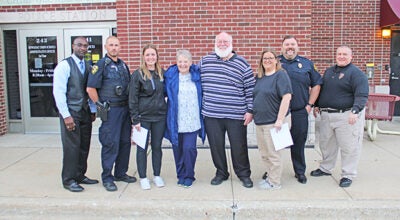Detective demonstrates lie detector test to high school class
Published 9:29 am Wednesday, November 25, 2015

Dowagiac Union High School junior Taylor Hulett answers questions from Michigan State Police Detective Kyle Gorham while hooked up a lie detector machine. Gorham was invited to Dan VandenHeede’s psychology classroom Tuesday to explain how police combine technology and physiology to help determine the truth from suspects. (Leader photo/TED YOAKUM)
For the first time in her life, Dowagiac Union High School junior Taylor Hulett was asked by her instructor to lie on an exam during her psychology class Tuesday morning.
The instructor, in this case, was Michigan State Police Detective Kyle Gorham. And the exam — a polygraph test, using actual equipment that state troopers use to aid in their investigations.
Gorham hooked up several sensors to Hulett before administering a short questionnaire to the junior to demonstrate how the lie detector machine was operated.
After giving several truthful answers to the first set of questions she was given, Gorham asked the student to lie about the number she had previously written on a piece of paper. In the process, he demonstrated the elevated breathing, heart rate and perspiration levels people experience whenever they tell a falsehood, no matter how minor.
The Michigan State Police officer was invited to share his knowledge of polygraph machines and how they operate with the students of Dan VandenHeede’s two psycology classes that morning. The officer explained how the police tool and psychology intersect to the around 60 students in both of the instructor’s two class periods.
This was the first time in several years that VandenHeede was able to get someone from the state police to show off the polygraph exam, which in years past was one of the highlights of the course, he said.
“We just got lucky,” he said. “I made the call a little while back, and the detective said he fit today into his schedule.”
Besides making a cool demonstration on one often mythologized aspect of police investigation, Gorham’s presentation reinforced the lessons that VandenHeede had given his students earlier in the year about the sympathetic and parasympathetic nervous systems, which govern the human body’s involuntary responses to crisis and conflict.
“This is a large part of what this course is all about,” VandenHeede said. “The machine serves as a tool, to let you monitor certain vital signs, but you’re also watching how the person reacts at the same time.”






